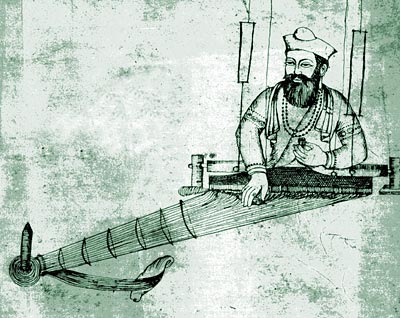By Balraj Puri
Kabir’s 612th Prakash utsava was celebrated throughout north India on June 26.
He belonged to a galaxy of saints who led a socio-cultural revolution in 16th century which laid the foundation of a unique composite culture of India. It included Bhakti movement of Hindu saints and Muslim saints who influenced one another.

Photo from Magic Carpet blog
Kabir was born into a Muslim Julaha (Weaver) family but joined the Vaishnava thinker, Ramanand, as a disciple. In the third stanza of Kabir parchai, he says “I belong to a Muslim caste. How can I obtain these prayer beads? The inner voice said to him. Take an initiation from Ramanand”. Kabir, Ravi Dass, Nabha Dass like sufi saints were never marginalised in real life but had a large number of admires and followers, including from elite and ruling classes, though by now they are owned by almost scheduled castes.
Once Sikander Lodi, who was then emperor of India, interrogated and even tortured Kabir, on the complaint of some orthodox persons, but he was ultimately convinced by the miraculous purity of Kabir’s heart and purpose and said, “the Kazis and mullahs do not understand you but the creator has accepted you word. The Ram, that you adore, is in fact real god.”
Sikander offered him several gifts, as a token of respect which, naturally Kabir declined and then walked back to his abode, followed by his Ram, which was another name of God, according to him.
Kabir was a householder who expected his God to grant him sufficient resources to feed his family and the occasional guest.
In the 19th century, there was emergence of religious divide and debate started on whether Kabir was a Hindu or a Muslim. At the same time, print culture had also arrived in a big way. Swami Parmanand’s Kabir Manshur was and such text. The air was particularly thick with sharp exchanges between Arya Samajis and Tablighis. Everybody was asked, as it were, to clearly identify him or herself as Hindu or a Muslim. The choice was projected back on Kabir as both communities owned him. Parmanand’s Kabir Manshur clinched the issue according to which “After some time, all the julhahs (who happened to be Muslims) gathered and asked Niru (Kabir’s father) to get his son circumcised in accordance with the commands and traditions of the prophet of Islam. A barber was duly summoned and he along with his knife reached the child, Kabir. Lo and behold, the child showed five penises to the barher and said cut whichever you like. On seeing this barber took flight and Kabir was spared circumcision.”
Those who have been engaged in a controversy whether he was a Hindu, a Nath Panthi, or a Muslim sufi would he baffled by this anecdote.
Kabir’s final departure was as dramatic as the rest of his life. He talked on the futility of the religious divide all his life but his ‘admirers’ fought over his body to settle the question: cremation or burial? Kabir had probably foreseen this drama, as one of his poems suggests.
“Hindu kahen hum hi le jaaron, Turk kahen mor pir
Dou aaye dinan main main jhagdein, dekhein hans Kabir
(The Hindu wants to burn my body but the Muslim resists: ‘How can you do this to my pir? The followers of both religious quarrel as Kabir the swan looks on)” (Bijak, pada 90)
Since Kabir had foreseen his followers enthusiasm regarding the ‘treatment’ his dead body should receive, he took care to make ‘suitable arrangements’. How did he feel as he made these arrangements?
Kabir himself called for some flowers, spread them over the sheet, wrapped himself up, asked his followers to sing bhajans and quietly ‘left’. It is unclear whether he left the world itself at that very moment or whether left the world of his followers, who were now free to divide, cremate and bury the flowers. Kabir had nothing to do with all this; he was on his way, alone. Or, more correctly, with his sadhana (spiritual endeavour), his poetry and his loneliness.
Kabir says, “I cry this world, I am not sure if somebody will cry for me, maybe he who knows the Sabad (word) will cry for me.”
Without a doubt. As long as there are words, he who knows the word will certainly cry for Kabir—the Sabad Sadhak.
Those who try to fit Kabir in the modern idiom as a symbol of Hindu-Muslim unity do not know the real Kabir who simply transcended this worldly divide at his spiritual height.
Links:
http://www.poetseers.org/the_poetseers/kabir/kabir_index/
http://www.kabirproject.org/

